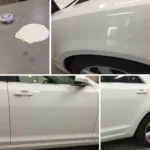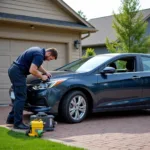Car painting repair is an essential aspect of vehicle maintenance, restoring both its aesthetic appeal and protective coating. Whether dealing with minor scratches, significant dents, or extensive collision damage, understanding the nuances of car paint repair can help you make informed decisions and ensure a high-quality, long-lasting finish. This guide will delve into the various aspects of car painting repair, from identifying the type of damage to selecting the right repair method and ensuring a flawless result.
Understanding Different Types of Car Paint Damage
Car paint damage varies in severity, from superficial clear coat scratches to deep dents that expose the metal underneath. Identifying the type of damage is crucial for determining the appropriate repair strategy. Clear coat scratches are the most common, affecting only the topmost layer of the paint. These can often be addressed with DIY solutions like polishing or scratch removers. Deeper scratches that penetrate the base coat require more involved repairs, such as touch-up paint or professional repainting. Dents, on the other hand, often necessitate bodywork before repainting can occur.
More severe damage, such as extensive paint chipping or rust, may require more complex procedures like sandblasting and rust removal before the repainting process can begin. Accurately assessing the damage helps determine the scope of the repair and prevents further complications down the line. Remember, early intervention is key to preventing further damage and minimizing repair costs.
Choosing the Right Car Painting Repair Method
The best car painting repair method depends on the extent and type of damage. For minor scratches and chips, how to repair a large paint chip on a car provides useful guidance. DIY solutions, like touch-up paint pens and scratch repair kits, are readily available and offer a cost-effective solution for minor imperfections. However, for more significant damage, professional intervention is often necessary. Professional car painting repair services utilize specialized equipment and techniques to ensure a flawless finish. This includes color matching, surface preparation, and application of multiple layers of paint and clear coat.
For larger areas of damage, repainting an entire panel or even the whole car might be required. This ensures color uniformity and a seamless blend. Understanding the different methods allows car owners to choose the most effective and cost-efficient approach for their specific situation. Consider factors like the visibility of the damage, the age of the car, and your budget when making your decision.
Ensuring a Flawless Car Painting Repair
Achieving a perfect car painting repair involves several crucial steps. Proper surface preparation is essential, including cleaning, sanding, and priming the affected area. This creates a smooth and even surface for the paint to adhere to. Accurate color matching is crucial for a seamless blend with the existing paint. Professional repair shops use advanced color-matching technology to ensure a perfect match. Applying multiple thin coats of paint allows for better control and minimizes the risk of runs or drips.
Finally, a clear coat application protects the new paint and adds a glossy finish. Following these steps ensures a durable, long-lasting repair that restores your car’s appearance to its former glory. Remember to allow sufficient drying time between each coat and after the final clear coat application. Proper aftercare, such as avoiding harsh chemicals and regular waxing, helps maintain the repaired area’s appearance. You can learn more about blending techniques at what is car paint repair blending. For information on repairing large chips, check out how to repair large car paint chips. If your car has large paint chips, consider repair large paint chips car. Another helpful resource is large paint chip repair on car.
Conclusion
Car painting repair plays a vital role in maintaining a vehicle’s aesthetics and value. Understanding the various types of damage, repair methods, and steps involved in achieving a flawless finish empowers car owners to make informed decisions. Whether opting for a DIY solution or seeking professional assistance, prioritizing quality and attention to detail ensures a long-lasting and visually appealing result. Car painting repair, when done correctly, can restore your car to its original beauty and protect it from further damage.
FAQ
- How long does car painting repair take?
- How much does car painting repair cost?
- Can I repair car paint damage myself?
- What is the best type of paint for car painting repair?
- How do I choose a reputable car painting repair shop?
- How do I care for my car after a paint repair?
- What is the difference between touch-up paint and repainting?
Common Car Painting Repair Scenarios
- Scenario 1: Minor scratches caused by car washes or tree branches.
- Scenario 2: Deep scratches that penetrate the base coat, often caused by keys or other sharp objects.
- Scenario 3: Dents and paint chips caused by minor collisions or road debris.
- Scenario 4: Extensive paint damage due to major accidents or hail.
Further Resources
- Check out our article on the different types of car paint.
- Learn more about protecting your car’s paint from damage.
- Explore our guide on car detailing and maintenance.
Need assistance with car painting repair? Contact us via WhatsApp: +1(641)206-8880, or Email: [email protected]. We have a 24/7 customer support team.


